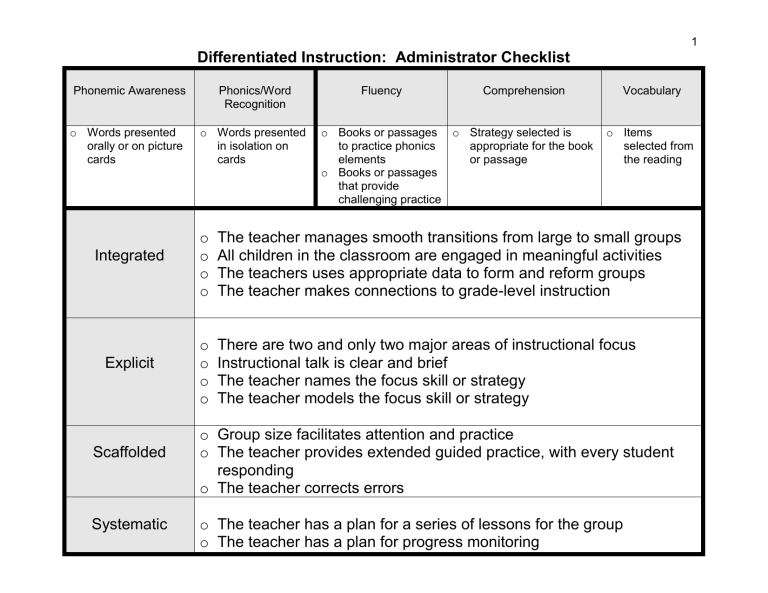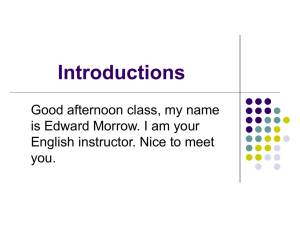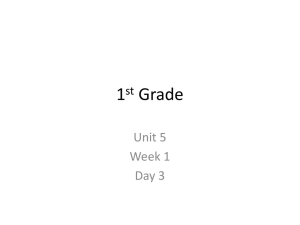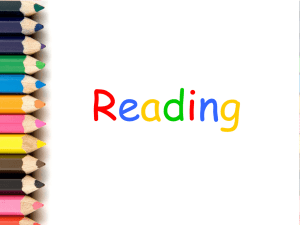Differentiated Instruction: Administrator Checklist
advertisement

1 Differentiated Instruction: Administrator Checklist Phonemic Awareness Phonics/Word Recognition o Words presented orally or on picture cards o Words presented in isolation on cards Integrated Explicit Scaffolded Systematic Fluency Comprehension o Books or passages o Strategy selected is to practice phonics appropriate for the book elements or passage o Books or passages that provide challenging practice Vocabulary o Items selected from the reading o o o o The teacher manages smooth transitions from large to small groups All children in the classroom are engaged in meaningful activities The teachers uses appropriate data to form and reform groups The teacher makes connections to grade-level instruction o o o o There are two and only two major areas of instructional focus Instructional talk is clear and brief The teacher names the focus skill or strategy The teacher models the focus skill or strategy o Group size facilitates attention and practice o The teacher provides extended guided practice, with every student responding o The teacher corrects errors o The teacher has a plan for a series of lessons for the group o The teacher has a plan for progress monitoring 2 Model Lesson #1: Differentiation for Phonemic Awareness, Phonics, and Word Recognition 1. Alphabet Review (3 Minutes) Alphabet Review o Sing the ABC song o Say the ABCs o Track the ABCs on an Alphabet Strip This lesson is for the very weakest group. The children don’t yet know the alphabet. o strip Aa Bb Cc Dd Ee Ff Gg Hh Ii Jj Kk Ll Mm Nn Oo Pp Qq Rr Ss Tt Uu Vv Ww Xx Yy Zz 2. Initial Sound Sorting (3 Minutes) Today we are going to work with words that have different beginning sounds. Some of our words will start like /s/ sun, /s/ sun, /s/ sun. Say that with me. /s/ sun. Others will start like /r/ rat, /r/ rat, /r/ rat. Say that with me. /r/ rat. Let’s do them together. Then the teacher models each item. “This is (a) _______. _______ rat? Or _____ sun? Now you try. First name the picture, then say rat or sun, then choose the same beginning sound. 3 4 3. Letter Names and Sounds (3 Minutes) The name of this letter is ___. What name?” (Students respond chorally.) “The sound of this letter is ____. What sound?” (Students respond chorally.) I am going to say a letter name and you point to it. I am going to say a letter sound and you point to it. I am going to show you a letter and you tell me the name. I am going to show you a letter and you tell me the sound. Rr Ss Aa 5 4. High-frequency Words (3 Minutes) Today we are going to learn to read and spell some really useful words. The first word is an. Say that word. Now watch me count the sounds in an: /a/ /n/. We hear two sounds. Say the sounds with me: /a/ /n/. Now watch me spell the word an. The first sound we hear in an is /a/, and it is spelled with the letter a. The second sound we hear in an is /n/, and it is spelled with the letter n. An has two sounds and two letters. Our next word is the. Say that word. Now watch me count the sounds in the /th/ /e/. We hear two sounds. Say the sounds with me: /th/ /e/. Now watch me spell the word the. The first sound we hear in the is /th/, and it is spelled with the letters th. The second sound we hear in the is /e/, and it is spelled with the letter e. The has two sounds and three letters. Now I’ll say a word and you point to it. Now I’ll say a word and you spell it. the an 6 5. Tracking Memorized Text (3 minutes) Now let’s sing a clean-up song. First sing with me: Clean up, clean up, everybody everywhere. Clean up, clean up, everybody do their share. Now I’m going to sing it and point it. Watch me. My finger touches the word when I say it. Now you do it with me. Clean up, clean up. Everybody everywhere. Clean up, clean up. everybody do their share. 7 Model Lesson #2: Differentiation for Phonemic Awareness, Phonics, and Word Recognition Say-it-and-move-it (5 minutes) This lesson is for a stronger group. The children know most of the consonant sounds, but they are having trouble with vowels First we are going to work on hearing the sounds in words. Line up your markers on your arrow, and get your finger ready to say it and move it. I’ll say a word. I’ll say my word slowly. Then I’ll say it and move it. Then you’ll say it and move it. pin, fig, lip, sip, mitt, pop, log, mom, top, fog Now you do them all on your own. I’ll say the word, you’ll say the word slowly, then you’ll say it and move it. 8 Sounding and Blending (5 minutes) Now we are going to sound and blend some words. The way that you do that is to look at each letter, say each sound out loud and then say them fast to make a word. “Listen to me. /p/ /i/ /n/ pin. Now you try: /p/ /i/ /n/ pin. Let’s do them all together. I’ll show you first and then you sound and blend. Now do them on your own. When you come to a word that you don’t know you can try to sound and blend it pin fig lip sip mitt pop log mom top fog 9 High-Frequency Words (5 minutes) Let’s practice some of our speed words. I’ll say a word and you point to it. (practice first four words) Now we are going to learn to read and spell two new words. The first word is eat. Say that word. Now watch me count the sounds in eat /e/ /t/. We hear two sounds. Say the sounds with me: /e/ /t/. Now watch me spell the word eat. The first sound we hear in eat is /e/, and it is spelled with the letters ea. The second sound we hear in eat is /t/, and it is spelled with the letter t. Eat has two sounds and three letters. Our next word is like. Say that word. Now watch me count the sounds in like /l/ /i/ /k/. We hear three sounds. Say the sounds with me: /l/ /i/ /k/. Now watch me spell the word like. The first sound we hear in like is /l/, and it is spelled with the letter l. The second sound we hear in like is /i/, and it is spelled with the letter i. The last sound we hear in like is /k/, and it is spelled with the letter k. The tricky thing to remember about like is that it has a silent e. We see that e but we don’t hear another sound. If you remember that, you can read and spell like. I’ll say a word and you point to it. I’ll say a word and you spell it. for Now I’ll say a word and you point to it. Now I’ll say a word and you spell it. from to make eat like 10 Model Lesson #3: Differentiation for Phonemic Awareness and Phonics Oral Segmenting and Blending (3 minutes) These children can sound and blend, but slowly. They are ready to work with patterns First we’ll work with the sounds in words. I am going to say some words slowly and I want you to say them fast. wed, ten, jet, fed, den, yet, sled, men, get, red, pen, let Now I will say some words fast, and I want you to say them slowly. wed, ten, jet, fed, den, yet, sled, men, get, red, pen, let Teaching Letter Patterns (8 minutes) Now we’ll work on reading and spelling three vowel patterns. The /ed/ pattern is the sound at the end of the word red. It is spelled e-d. The /en/ pattern is the sound at the end of the word ten. It is spelled e-n. The /et/ pattern is the sound at the end of the word jet. It is spelled e-t. First I want you to listen to some words and tell me whether they sound like red, ten, or jet. Point to the right sound. wed, ten, jet, fed, den, yet, sled, men, get, red, pen, let Now I’ll read you a word and I want you to spell it on your white board. Remember to use your patterns. Words that end like red are spelled –ed; words that end like ten are spelled – en; words that end like jet are spelled –et. wed, ten, jet, fed, den, yet, sled, men, get, red, pen, let -ed -en -et Phonemic Awareness, Phonics, and Word Recognition Integrated Explicit o The teacher manages smooth transitions from large to small groups o All children in the classroom are engaged in meaningful activities o The teachers uses appropriate data to form and reform groups o The teacher makes connections to gradelevel instruction o There are two and only two major areas of instructional focus o The teacher names the focus skill or strategy o The teacher models the focus skill or strategy o Group size facilitates attention and practice Scaffolded o The teacher provides extended guided practice, with every student responding o The teacher corrects errors o The teacher has a plan for a series of Systematic lessons for the group o The teacher has a plan for progress monitoring 11 These data include letter-name inventories, letter sound inventories, spelling inventories, and high-frequency word inventories. They identify exactly which items the children need to learn. Letter cards from the core are reused to prevent confusion. For phonemic awareness, this must be segmenting or blending; for word recognition, this must be letter names, letter sounds, letter patterns, or specific highfrequency words. The teacher must use manipulatives or gestures for phonemic awareness; the teacher must demonstrate the procedures directly. The teacher models each item, with all students responding; then all students practice individually at the same time. The lesson plans target different letters and words each day, but the strategy is the same; the teacher periodically tests the items that have been taught.







